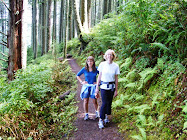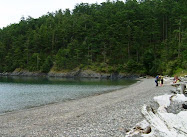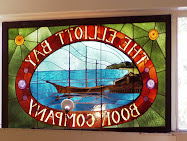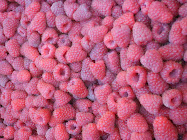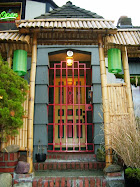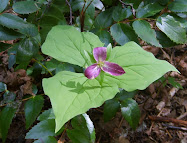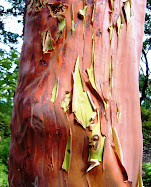
Anytime of year Portland is a fun city, so don’t put off your weekend in town just because it’s winter. Too many months have passed since my last trip to Portland, so last weekend I dash down for an overnight. What can you do during a quick overnight trip? Plenty.
Saturday MorningI-5 is smooth sailing when I leave Seattle at 7:30 a.m. on Saturday. I know it sounds brutal to some of you, but a morning drive is much faster than the Friday evening “slog” from Seattle to Portland along the I-5 corridor.
I’m meeting some girlfriends for breakfast at
Mother’s Bar & Bistro in Old Town in downtown Portland. On a weekend morning, the line for a table can wind halfway down the block. Since I’m late and my friends are already seated, I scoot right in past the clumps of people waiting in the entrance area. With a name like Mother’s, think comfort food. And big portions. “You’ve got to taste this!” says Karen, pushing her plate in my direction.

My huge bowl of oatmeal is okay, but Karen’s French toast dipped in corn flakes is what I wish I’d ordered. Sounds odd but it works—sweet, soft, yet crunchy. Becky’s frittata is cheesy and perfectly cooked. I don’t taste Kathy’s eggs Benedict, but I notice she cleans her plate.
Saturday AfternoonNext I head to Troutdale, gateway to the Columbia River Gorge, to visit my mom. When I step out of the car, a gust of East Wind hits me. As much as I hated how the wind chapped my hands and legs walking home from school, I’m happy to feel its clarifying chill again.
Troutdale got a facelift about a dozen years ago, and now the main (and only) street through downtown has some stop-worthy shops. I duck into
Troutdale General Store to grab a sandwich. The General Store serves up old-fashioned scoops of ice cream, good sandwiches, all the candy you’d care to eat and more. I even find a birthday gift for my nephew while I’m waiting for my tuna on whole wheat.

Be sure to grab a latte at the in-store cafe and browse though
Celebrate Me Home, a home store stuffed with oversized, elegant lodge-style furniture, cool home accessories, note cards, and fine papers.
Late afternoon I drive back to downtown Portland to check into my room at
Ace Hotel on the edge of the Pearl District. I hear that the Ace is the place for hip, creative types. Indeed the clientele is decidedly sub-40 and casually chic. The high-ceiling lobby opens on one side to a
Stumptown Coffee shop and on the other to
Clyde Common restaurant.

Ace’s look is a blend of contemporary minimalist in an old 1920-era building. The former Clyde Hotel was stripped down and renovated in a spare but comfortable style—long hallways, mostly whitewashed walls, polished wood floors, simple but comfortable furnishing. If you’re not out clubbing all night and want some sleep, ask for earplugs at the front desk. They’ve got plenty. The pillows are also too big for my taste. When I mention it at checkout, the young concierge tells me “Next time pull the pillow out of its case and it’ll smooth down.”
Parking can problematic near the Ace if you don’t want to drop $20 for valet service. I was lucky to find a metered spot on the street a block away late Saturday afternoon and didn’t have to move it on Sunday morning.
But the best thing about the Ace is its location. Can you get any better than being just a block from
Powell’s Books? Not in my book. More than one lofty source has called Powell’s the best bookstore in U.S., if not the world.

I wander over and browse for a while before dinner, managing to escape with buying only four books.
Saturday NightSince my hotel is so conveniently located, I walk the 8 blocks to meet some friends for dinner and movies at McMenamin’s
Mission Theater in Northwest Portland. (I could have hopped the new street car for half the trip but I wanted the exercise.) For just $3, we get in to a double feature in this former Swedish Evangelical Mission and union hall turned cinema. Matt grabs three seats on the main floor below the balcony, and we line up to order drinks and dinner. The fare here is burgers, sandwiches, and salads. My tasty gyro sandwich is wrapped in a soft, warm pita accompanied by a good green salad. The only downside is the slow service. Larry gets his sandwich and finishes it, then my sandwich arrives and I finish it, and Matt’s burger finally arrives 45 minutes after placing his order.
After the movies we stop by the historic
Heathman Hotel’s Marble Bar for drinks. This street-level space is right off the main entrance on Broadway in the heart of downtown. “Can I see a dessert menu?” says Larry, who’s struck with a late evening sweet tooth. His artfully arranged cherry chocolate confection looks exquisite and disappears fast. I sneak a few bites of chocolate.
We make our way back to Ace Hotel and hang out on the comfy sofas in the lobby, talking and sipping drinks from Clyde Commons. When I head to my room after midnight, the restaurant is still buzzing.
Sunday Morning
Sunday morning the city is covered with a thin layer of fresh snow. Thankfully it’s not enough to mess up the roads. My brother and his wife meet me for breakfast next to the hotel at
Kenny and Zuke’s Delicatessen (where I coincidentally bump into a friend from Seattle). This classic New York-style Jewish deli is sunny and spacious, with exposed brick walls, friendly service, and fresh, oversized bagels. My poached egg is cooked just right, and the huge schmear of cream cheese served with my bagel could spread a dozen bagels.
After another trip over to Powell’s Books, I stop in Stumptown Coffee and pick up a fresh berry scone for the road. Forget Starbuck’s and their mass-produced baked goods—Stumptown offers truly excellent and freshly baked local pastries, muffins, and scones that are worth the calories. By noon I’m on my way back north to Seattle. Next time I’ll stay another night and leave more time for Powell’s.
When You GoMy single room with a private shower at the Ace Hotel is $135, which is moderately priced for downtown Portland. You can dowload a
map of downtown Portland or pick up a freebie map of downtown at Powell's Books on Burnside.

 Sometimes you hit it just right and have one of those epic days. Years ago a friend and I were skiing up at Blackcomb the first weekend in June when most everyone else had long since moved on to their sailboats or tennis courts. For several days prior, it snowed a couple feet in an unusual late spring storm. When we got to the top of the mountain, we had the place almost to ourselves. And then the lower mountain lift malfunctioned for a while and no one else was coming up. Can you say skier’s nirvana? All that untracked fresh snow, most of the other skiers down below. Matt and I sliced our figure 8 signatures all over Seventh Heaven. I still smile when I think about it.
Sometimes you hit it just right and have one of those epic days. Years ago a friend and I were skiing up at Blackcomb the first weekend in June when most everyone else had long since moved on to their sailboats or tennis courts. For several days prior, it snowed a couple feet in an unusual late spring storm. When we got to the top of the mountain, we had the place almost to ourselves. And then the lower mountain lift malfunctioned for a while and no one else was coming up. Can you say skier’s nirvana? All that untracked fresh snow, most of the other skiers down below. Matt and I sliced our figure 8 signatures all over Seventh Heaven. I still smile when I think about it.













































